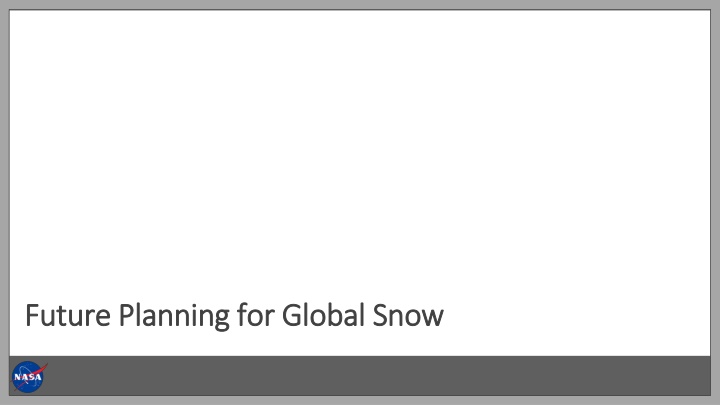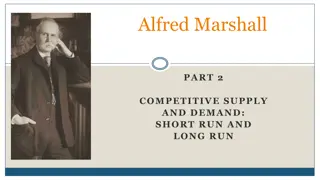
Innovations in Global Snow Monitoring and Planning
This comprehensive document outlines future planning and advancements in global snow monitoring. It discusses upcoming satellite missions, potential opportunities for spaceborne snow observations, strategic planning for missions, and engaging the snow community. Key topics include research priorities, observation gaps, strategic positioning, and uncertainties in maritime snow monitoring. Experts' contact details are also provided for collaboration.
Uploaded on | 2 Views
Download Presentation

Please find below an Image/Link to download the presentation.
The content on the website is provided AS IS for your information and personal use only. It may not be sold, licensed, or shared on other websites without obtaining consent from the author. If you encounter any issues during the download, it is possible that the publisher has removed the file from their server.
You are allowed to download the files provided on this website for personal or commercial use, subject to the condition that they are used lawfully. All files are the property of their respective owners.
The content on the website is provided AS IS for your information and personal use only. It may not be sold, licensed, or shared on other websites without obtaining consent from the author.
E N D
Presentation Transcript
Future Planning for Global Snow Future Planning for Global Snow
THP Snow THP Snow Roadmap Roadmap 2
Timeline driven by upcoming satellite missions and opportunities Potential opportunities for spaceborne snow observations: Earth Venture Mission NISAR L-band InSAR TSMM Ku-band SAR SBG Hyperspectral Earth System Explorer (ESE) Identify possible satellite technologies that meet mission criteria Define activities required to evaluate potential concepts New techniques and advances are being demonstrated with existing satellites: C-band SAR - Sentinel-1 Stereo-photogrammetry Worldview, Planet, Pleiades Spaceborne lidar ICESat-2, GEDI 3
Future Planning Breakout group charge: What activities are missing/essential? How does the timeline match with upcoming deadlines? What partnerships or other opportunities should we be aware of? 4
Breakout Group: Strategic Planning Science-Application-Mission Vision & Goals Mission Considerations Observation Gaps Time/Space Resolution Timeline Discussion: 1) What are the research, reviews, and answers that must be ready by proposal time? Paper/Proposal list: https://drive.google.com/drive/folders/1d-k155K5RXCSu3lHPGEWqjxZzVyvdeNj Snow mission science vision: https://docs.google.com/document/d/1BtxGKMOB3eOACJVPCMYUaZOeLUjAplO-tABnWgB3IGg/edit?usp=sharing 2) How do we prioritize research, roadmap tasks, etc (with a limited time and budget)? 3) How to we focus and motivate the snow community towards a mission? 4) How do we strategically position our community for success? Paul Houser (phouser@gmu.edu) Ana Barros (barros@duke.edu)
Mike Durand (durand.8@osu.edu) Chris Hiemstra (Christopher.A.Hiemstra@erdc.dren.mil)
Breakout Group: Maritime snow Discussion points: What are the most critical uncertainties about snow in the maritime zone? What are the biggest challenges to remote sensing of snow in the maritime zone? Where/when? How can ground-based networks and models be used to overcome these snow remote sensing challenges? What measurement and model advances are needed? What strategies/technologies are needed to improve within and below canopy process understanding and characterization of snow in maritime forests? What knowledge about snow processes and sensing might be transferable to the maritime zone from SnowEx campaigns in other snow zones (tundra, taiga, continental, prairie, etc.)? What is less likely to transfer due to the uniqueness of maritime snow? Leads: Liz Burakowski (elizabeth.burakowski@unh.edu) Mark Raleigh (raleigma@oregonstate.edu)
Breakout Group: Prairie Snow Why Prairie snow? Prairies cover almost 1/3 of the Earth s land surface globally important for agriculture, water management, flooding concerns, energy & carbon cycle interactions, ecological issues, etc. Low stature vegetation, wind redistribution, subtle topography, rapidly changing conditions, and shallow snow create unique snow heterogeneity Winter 2021 planned activities:local-scale campaign at CARC, MT UAV Lidar & albedo, hyperspectral, UAVSAR flights, ground meteorology, snow, & soil Key questions to discuss (not limited) 1. What are the current gaps in remote sensing of prairie snow? Impact of substrate characteristics (vegetation, soil composition & moisture, and freeze-thaw state) on remote sensing techniques Characterizing spatial heterogeneity of snow (especially wind-driven redistribution, sublimation) Rapidly changing conditions (metamorphism, wet snow, etc.) 2. What sensors might be beneficial (shallow, transitional snow) esp. path to space? L-band InSAR, Lidar, multi-band SAR/radiometer, hyperspectral, Gamma radiation, SfM, others? 3. Which opportunities/collaborations should we be aware of? Agricultural & ecological communities, Canadian agencies & universities, flood forecasters, others? Prairie snow group Sam Tuttle (setuttle@syr.edu) , Eunsang Cho (ec1072@wildcats.unh.edu)
Breakout Group: Observing System Simulation Experiment (OSSE) 1. 2. What is the OSSE community currently doing? Components of current OSSE: Sensor types to explore? Orbital simulator (a.k.a., space-time subsampler)? Observation operators? Radiative transfer model; machine learning; others? Error characteristics? Land surface models used? Fraternal versus synthetic twin? End-user applications? Water availability? Drought and/or flood prediction? Economic impacts? Other ideas / comments / questions / concerns? 3. Bart Forman, baforman@umd.edu Sujay Kumar, sujay.v.kumar@nasa.gov 9





